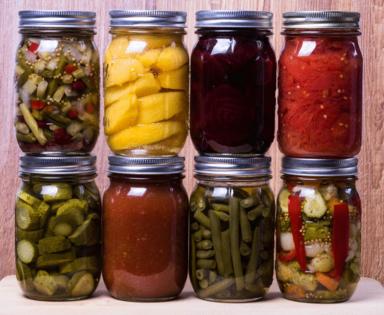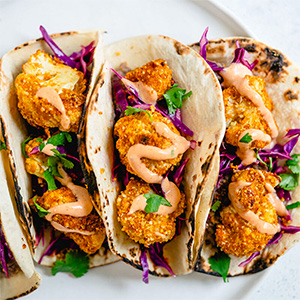5 recipes that let you show off your preservation skills
Published in All About Wine
You can learn a lot about what’s on the minds of culinary professionals by the types of cookbooks being published.
We’ve seen waves of baking books and tomes inspired by global cuisines (Italian and Korean cooking are especially popular). Now food preservation is having a literary moment, and the timing couldn’t be better.
To help you make the most of summer’s bounty, we plucked recipes from two of several new cookbooks: “Preserving the Seasons” by Holly Capelle (Simon Element, $29.99) and “The Pickle Jar” from Nick Vadasz (Hamlyn, $24.99).
In no time, both will have you canning, fermenting, pickling, dehydrating or freezing the best produce of the season. Each also provides detailed instructions and tips for both beginner and seasoned cooks, and recipes that will appease adventurous eaters and pickle purists alike. Here’s a sampling.
Quick-Pickled Lavender Carrots
Makes 2 pints.
The combination of lavender and carrots results in a delightfully spiced pickled snack. Add them to salads or use as garnish for a Bloody Mary. From “Preserving the Seasons” by Holly Capelle (Simon Element, 2025).
4 fresh lavender sprigs
2 fresh thyme sprigs
1 lb. fresh carrots, peeled and cut into 3-in.-long sticks or ⅓-in.-thick rounds
1 c. apple cider vinegar
1 c. water
½ c. sugar
2 tsp. pickling or canning salt
1 tsp. coriander seeds
½ tsp. whole black peppercorns
1 (3-in.) cinnamon stick
3 whole cloves
Directions
Divide the lavender and thyme sprigs between 2 sterilized wide-mouth pint jars. Pack in the carrots, trimming the ends as needed, leaving a little more than ½-inch headspace.
In a nonreactive saucepan, bring the vinegar, water, sugar, salt, coriander, peppercorns, cinnamon stick and cloves to a boil over high heat, stirring until the sugar is dissolved. Turn the heat down to low and simmer for 10 minutes to blend the flavors.
Ladle the hot brine over the carrots until completely covered, leaving ½-inch headspace. Remove any air bubbles, wipe the rims clean, and secure the lids. Cool completely. Label and date. Refrigerate for 1 to 3 days before opening, and use within 3 months.
Pineapple, Strawberry and Cucumber Salsa
Makes about 2 ½ cups.
This is a magical mix of luscious fruit, aromatic herbs and fiery spice. The key to success here is to ferment for just a day or so before transferring to the relative safety of the fridge. Fruit, with its naturally high sugar content, runs the risk of rapidly sending your lacto-fermentation on a one-way ticket to an alcoholic cocktail. Make small batches to mitigate the risk of spoilage and wastage. I use this salsa to liven up tacos and tostadas, or serve it ice cold as a spicy fruit or seafood cocktail. From “The Pickle Jar,” from Nick Vadasz (Hamlyn, 2025).
10 ½ oz. (about 1 ¾ c.) fresh pineapple chunks, quartered if large
7 oz. (about 1 ½ c.) strawberries, hulled and quartered
½ English cucumber, quartered lengthways and diced
1 ½ tsp. fine sea salt
Juice of 1 lime
1 tbsp. gochugaru (Korean red pepper flakes)
1 thumb-sized piece of fresh ginger root, scrubbed and finely chopped
1 clove garlic, crushed
1 red chile, finely chopped
1 handful of mint, chopped
1 handful of cilantro, chopped
Directions
Put the pineapple, strawberries and cucumber in a large mixing bowl with the salt and mix gently with your hands.
Add the lime, gochugaru, ginger, garlic, chile, mint and cilantro and mix again well with your hands.
Cover the bowl loosely with a clean tea towel and leave the fruit and cucumber mix to macerate for 20 minutes or so.
Pack into thoroughly cleaned 8- or 16-ounce lidded food storage containers. Leave to ferment at room temperature for a day or so, checking and tasting regularly for just a hint of fizz before storing in the fridge until needed, where it will keep for a week or so.
Roasted Marinara Sauce
Makes 4 cups.
You can use home-canned, store-bought canned or fresh tomatoes here. Roasting the tomatoes makes the sauce next-level good. This sauce is also delicious on pizza and pasta or as a dipping sauce for homemade focaccia. From “Preserving the Seasons” by Holly Capelle (Simon Element, 2025).
2 (28-oz.) cans whole tomatoes, 2 quarts home-canned tomatoes or 2 lb. ripe fresh tomatoes, cut into quarters lengthwise
4 cloves garlic, smashed under a knife and peeled
3 tbsp. extra-virgin olive oil, divided
1 tsp. kosher salt, plus more as needed
½ tsp. freshly ground black pepper, plus more as needed
1 large yellow onion, chopped
1 tbsp. sugar, plus more as needed
1 tbsp. chopped fresh basil or 1 tsp. dried
1 tbsp. chopped fresh oregano or 1 tsp. dried
Directions
Preheat the oven to 400 degrees.
Spread the tomatoes in a 9- by 13-inch baking dish. (If using canned tomatoes, reserve the juices for use later in the recipe.) Add the garlic. Drizzle with 2 tablespoons of the oil. Sprinkle with the salt and pepper. Roast, stirring occasionally, until the tomatoes have shrunk and the edges are beginning to char, 1 to 1¼ hours.
Remove the roasted garlic cloves; let cool until easy to handle and then coarsely chop.
Heat the remaining 1 tablespoon of oil in a large saucepan over medium heat. Add the onion and a pinch of salt and pepper. Cook, stirring occasionally, until softened, about 3 minutes. Add the roasted garlic and cook for 1 minute. Carefully transfer the roasted tomatoes and their juices, as well as any reserved juices, to the pot. Bring to a simmer. Remove from the heat. Using an immersion blender, purée.
Return to low heat and stir in the sugar, basil and oregano. Cover and simmer over low heat, stirring often, to blend the flavors, about 10 minutes. Taste and add more salt, pepper and sugar to taste. Serve hot. Leftovers can be cooled, covered and refrigerated for up to 1 week or frozen for up to 3 months.
Jalapeño Relish
Makes about 2 ½ cups.
This is a hot, spicy, super-quick chile relish that works well in Mexican dishes, though you’ll be tempted to add it to almost everything you eat. Make sure to chop all the veggies small enough to allow them to blend easily and evenly. From “The Pickle Jar,” by Nick Vadasz (Hamlyn, 2025).
For the relish:
8 to 12 mixed red and green chiles, chopped
2 green peppers, cored, deseeded and chopped
2 small onions, chopped
4 cloves garlic, peeled but kept whole
1 bunch of cilantro, roughly chopped
For the brine and seasoning:
7 tbsp. (3 ½ oz.) apple cider vinegar
2 tbsp. olive oil
½ tsp. cumin seeds
½ tsp. coriander seeds
½ tsp. ground turmeric
1 ½ tsp. fine natural sea salt
1 tbsp. sugar
Directions
Put all the ingredients for the relish in the large bowl of a food processor and pulse until you have a fine texture – you might need to do this in batches, depending on the size of your machine.
Empty the relish into a large mixing bowl, add all the ingredients for the brine and seasoning and mix well to combine. Taste for salt, adding more if needed.
Transfer the relish to a lidded food storage container. Use right away, and store the remainder in the fridge, where it will keep for a month.
Tortilla Chips with Fresh Salsa and Eggs
Serves 4.
Somewhere in the world between a shakshuka and chilaquiles lives this really satisfying brunch dish, where whole eggs are broken onto a stack of fried tortilla chips, which are simmering in fresh jalapeño relish salsa, creating a soft pie that’s formed as the salsa is absorbed by the chips. Done right, it retains some crispy textures, too. From “The Pickle Jar,” by Nick Vadasz (Hamlyn, 2025).
For the salsa:
4 large ripe tomatoes
1 red pepper, halved, cored and deseeded
1 onion, halved and peeled
2 cloves garlic, unpeeled
2 tbsp. olive oil
1 tbsp. Jalapeño Relish (see recipe)
Salt and pepper
For the eggs:
1 tbsp. olive oil
6 to 7 oz. of plain tortilla chips
4 eggs
1 handful of grated Cheddar or mozzarella cheese
To serve:
4 tbsp. Jalapeño Relish (see recipe)
2 tbsp. sour cream
4 pinches chopped cilantro
4 lime wedges
To prepare the salsa: Heat a large frying pan over medium-high heat, add the tomatoes, red pepper, onion and garlic and cook for about 5 to 6 minutes, until you have good blackened patches on all the vegetables.
Take the pan off the heat. When cool enough to handle, peel the garlic, add to a food processor or blender with the other charred vegetables, olive oil, jalapeño relish and salt and pepper, to taste. Blend until you have a smooth salsa.
To prepare the eggs: Add the 1 tablespoon olive oil to the frying pan, followed by the salsa, and bring to a very gentle simmer. Add the tortilla chips, stirring just enough to submerge some but not all of them. Break the eggs onto the chips at quarter intervals around the pan to create portions when you come to serve it, then sprinkle with the cheese.
Cover the pan and cook the eggs very gently — they should cook both from the salsa beneath them and the steam above them under the lid. Check to see if they are done after 3 to 4 minutes; be sure the whites are firm.
Using a large spatula, shovel the portions onto warmed plates and garnish each with a tablespoon of jalapeño relish, ½ tablespoon sour cream, a pinch of chopped cilantro and a lime wedge.
©2025 The Minnesota Star Tribune. Visit at startribune.com. Distributed by Tribune Content Agency, LLC.










Comments